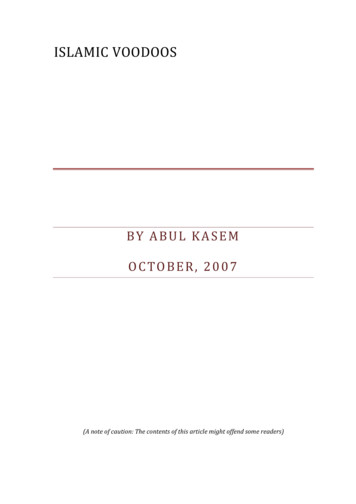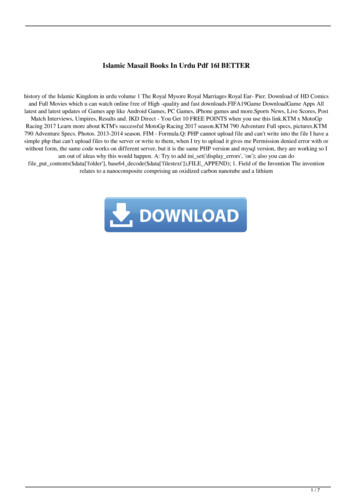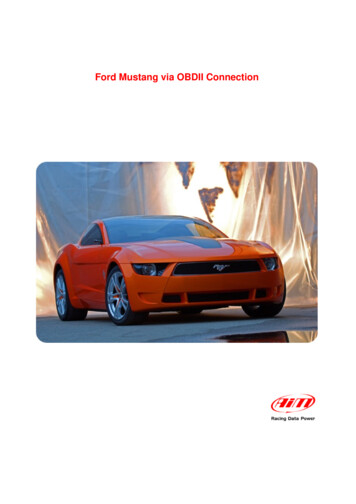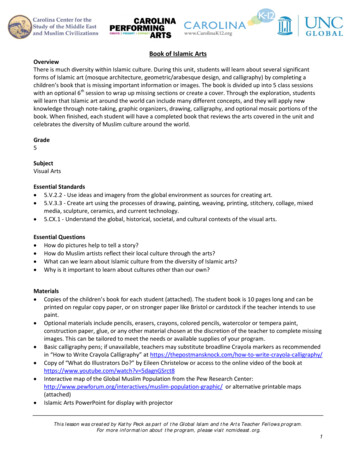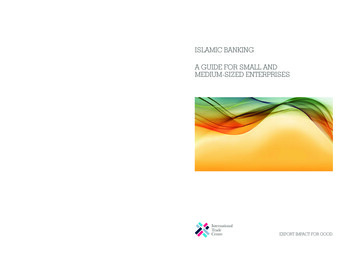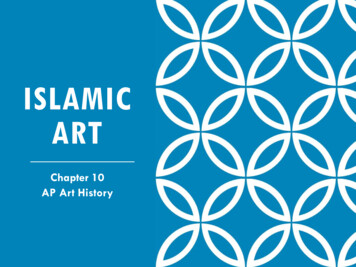
Transcription
ISLAMICARTChapter 10AP Art History
BIG IDEAS & ESSENTIALQUESTIONS OF ART HISTORYBig IdeaEssential QuestionArtists manipulate materials and ideas tocreate an aesthetic object, act, or event.What is art and how is itmade?Art making is shaped by tradition andchange.Why and how does artchange?Interpretations of art are variable.How do we describe ourthinking about art?
HAGIA SOPHIAKHAN ACADEMYVIDEOSHagia Sophia, IstanbulHagia Sophia as amosqueTheotokos mosaic, apse,Hagia Sophia, IstanbulDeesis mosaic, HagiaSophia, Istanbul
Known in Spain as Mezquita-CatedralOne of the oldest structures from theMuslim rule of Spain Muslims ruled Iberia (Spain, Portugal,and part of France) in the 8th centuryWhat was here 1st? Possibly a temple to the Roman godJanus Converted to a church by the invadingVisigoths (572) Rebuilt (784) as a mosque by Umayyaddescendants. Converted to a church in 1236GREAT MOSQUE OFCORDOBACordoba became the new capital of theUmayyads after the Abbasid conquestof Damascus. Abd al-Rahman I encouragedELABORATE construction projects They imported fruit trees and otherplants (orange trees still found in GreatMosque courtyard)!
The Great Mosque was expandedover a 200 year period. Large Hypostyle Hall A courtyard with a fountain An orange grove A covered walkway circling thecourtyard A minaret (now encased in a belltower)THE HYPOSTYLE HALLInternal Decoration of Cordoba Overlapping horseshoe arches Slender columns in the HypostyleHall (recycled ancient Romancolumns) Crossing ribs form an intricatedecorative pattern Walls are covered with marble andcostly mosaics Repeated geometry isEVERYWHERE!
EXTERIOR ENTRANCE &MIHRAB WITH DOME
GREAT MOSQUE(CORDOBA)PLAN
PYXIS OF ALMUGHIRALuxury Arts centers: courts of the caliphs and sultans Cordoba was a center for luxury goodproductionWhat is a pyxis? A cylindrical box used for cosmeticsWhy is this pyxis important? Produced for al-MughiraArtist: UnknownThis ivory carving with traces of jadeDecorated with animals and huntersScrolling vines surround 4 medallionsInscription: a prayer for the 18 yr. old prince’swell being: “God’s blessing, favors, andhappiness to al-Mughira, son of the commanderof the faithful, may God have mercy upon him,in the year 357”
THE ALHAMBRA ANDGENERALIFEAlhambra contains 1 mile ofwalls and 30 towers of varyingsize.There are 26 acres that includestructures with 3 distinctpurposes: A palace A fortress and barracks(Alcazaba) The city (medina) near thePuerta del Vino (Wine Gate)where the court officials livedand workedWere the parts of the complexconnected? YES! By paths, gardens, andgates. Each portion could be blockedin the event of a threatInterior spaces are highly ornate! Contrasts the plain walls outside
THE ALHAMBRA:QAL’AT AL-HAMRA (RED FORT)Who constructed this work? The Nasrid Dynasty (12321492) The last Muslims to rule in Spain. Muhammad ibn Yusuf ibn Nasr(Muhammad I) beganconstruction of the complex(1238)Alhambra is a palace fortress Muslim Medieval palace Sophisticated planning Complex decorative program Beautiful gardens and fountainsHow many palaces are found inthe walls? 3 – the most celebratedstructures Comares Palace The Palace of the Lions The Partal Palace Each constructed in the 14thcentury
What is contained in the Comares Palace? The façade is built on a raised three-stepped platform thatmight have served as a kind of outdoor stage for the ruler. The carved stucco façade was once painted in brilliantcolors, though only traces remain. A covered patio surrounding a large courtyard with a pool,now known as the Court of the Myrtles: the focal point ofthe Comares Palace. The Comares Tower, contains the Salón de Comares (Hall ofthe Ambassadors), a throne room built by Yusuf I (13331354). This room exhibits the most diverse decorative andarchitectural arts contained in the Alhambra.THE COMARES PALACE
THE PALACE OF THE LIONSIMAGE SHOWN: COURT OF LIONSSEE PGS. 299The Palace of the Lions stands next to theComares Palace This palace but should be considered anindependent building. The two structures were connected afterGranada fell to the Christians.What portion of this palace is mostimportant? The Court of Lions Constructed by Muhammad V in the 14thcentury Contains a fountain with a complexhydraulic system a marble basin on the backs of twelvecarved stone lions Sits at the intersection of two waterchannels An arched covered patio encircles thecourtyard Two decorative pavilions project into thecourtyard on an East–West axis
Inside the Palace of Lions: West: The Muqarnas Chamber is near the originalentrance to the palace. It takes its name from the intricately carved systemof brackets called "muqarnas" that hold up thevaulted ceiling. East: is the Hall of the Kings an elongated space divided into sections using aseries of arches leading up to a vaultedmuqarnas ceiling This room contains paintings on the ceilingrepresenting courtly life. The images were first painted on tannedsheepskins, in the tradition of miniature painting. They use brilliant colors and fine details and areattached to the ceiling rather than painted on it.There are two other halls in the Palace of the Lions the Hall of the Two Sisters and the Hall theAmbassadors Both were residential apartments with rooms on thesecond floor.
PETRA, JORDAN:TREASURY AND GREATTEMPLEPetra is the greatest city of the Nabataeans.Who are the Nabataeans? A great trading people who occupied theSinai and Negev. Controlled luxury trades in incense duringthe late Hellenistic & early Roman periodsWhat happened in the late Roman era? Ruled in this region until 106 CE Emperor Trajan moved the capital to Bosra– creating the province of ArabiaWhat did scholars originally think thiswas? A necropolis – there are many at PetraWhat do we know today? Petra was a Hellenistic-style metropolis The treasury façade reveals the influenceof Alexandria (broken pediment/centraltholos/Corinthian columns)
The sculptural decoration also underscores aconnection to the Hellenistic world.On the upper level, Amazons (bare-breasted)and Victories stand, flanking a central femalefigure (on the tholos), who is probably IsisTyche, a combination of the EgyptianGoddess, Isis, and Tyche, the Greek Goddessof good fortune.The lower level features the Greek twin gods,Castor and Pollux, the Dioscuri, who protectedtravelers and the dead on their journeys.There are other details from the artistictraditions of the Hellenistic world, includingeagles, the symbols of royal Ptolemies, vines,vegetation, kantharoi (vase with largehandles), and acroteria (architecturalornaments on a pediment).The tomb also features rosettes, a designoriginally associated with the ancient NearEast.
The treasury was exceptionalfor its figurative detail andornate Hellenistic architecturalorders.Most tombs did not havefigurative sculpture—a legacyof the Nabataean artistictradition that was largelyaniconic, or non-figurative.Many of the smaller tombswere less complex and alsodrew far less upon the artisticconventions of the Hellenisticworld, suggesting that theNabataeans combined theartistic traditions of the Eastand West in many differentand unique ways.
THE KA’ABAPilgrimage to a holy site is a coreprinciple of almost all faiths.The Kaaba, meaning cube in Arabic, isa square building elegantly draped ina silk and cotton veil.Located in Mecca, Saudi Arabia, it isthe holiest shrine in Islam.All Muslims aspire to undertake the hajj,or the annual pilgrimage, to the Kaabaonce in their lives if they are able.Prayer five times a day and the hajjare two of the five pillars of Islam, themost fundamental principles of the faith.Upon arriving in Mecca, pilgrims gatherin the courtyard of the Masjid al-Haramaround the Kaaba.They then circumambulate in hopes ofkissing or touching the Black Stone n thecorner of the structure.
DOME OF THE ROCKThe Dome of the Rock is a building ofextraordinary beauty, solidity,elegance, and singularity of shape Bothoutside and inside, the decoration isso magnificent and the workmanship sosurpassing as to defy description.The greater part is covered with gold sothat the eyes of one who gazes onits beauties are dazzled by its brilliance,now glowing like a mass of light,now flashing likelightning.—IbnBattuta (14th century travel writer)
One of the most iconic images ofthe Middle East is the Dome of theRock shimmering in the setting sunof Jerusalem.Sitting atop the Haram al-Sharif, thehighest point in old Jerusalem, theDome of the Rock’s golden-colorDome and Turkish Faience tilesdominates the cityscape of OldJerusalem and in the 7th centuryserved as a testament to the powerof the new faith of Islam.The Dome of the Rock is one of theearliest surviving buildings fromthe Islamic world.This remarkable building is not amosque, as is commonly assumedand scholars still debate its originalfunction and meaning.
Between the death of the prophet Muhammad in 632 and 691/2, whenthe Dome of the Rock was completed, there was intermittent warfare inArabia and Holy Land around Jerusalem.The first Arab armies who emerged from the Arabian peninsula werefocused on conquering and establishing an empire—not building.The Dome of the Rock was one of the first Islamic buildings everconstructed.The Dome is located on the Haram al-Sharif, an enormous open-airplatform that now houses Al-Aqsa mosque, madrasas and severalother religious buildings.Few places are as holy for Christians, Jews and Muslims as the Haramal-Sharif. It is the Temple Mount, the site of the Jewish second temple, whichthe Roman Emperor Titus destroyed in 70 C.E. while subduing theJewish revolt; a Roman temple was later built on the site. The Temple Mount was abandoned in Late Antiquity.
GREAT MOSQUE, ISFAHAN(MASJID-E JAMEH)Most cities with a sizable Muslim population have acongregational mosque.Congregational mosques are often expanded alongwith the growth and needs of the umma (Muslimcommunity)The Great Mosque of Isfahan Found in Iran Unique in that it has changed from the 8th to 20thcenturies Found at the center of the old city Shares wall with surrounding structures This is a place for prayer!Who began construction of this work? The Seljuk Turks c. 11th Century Isfahan became their capital at this time.
Who continued construction on thiswork? The Il-Khanid, Timurid, Safavid,and Qajar rulersWhat kind of design is found in thisstructure? Four-iwan design: an iwan is avaulted space that opens on oneside to a courtyard Great Mosque of Isfahan isconsidered the prototype forfuture four-iwan mosquesWhat links the four iwans? The central courtyard Providing a tranquil space
The Qur'an is the sacred text ofIslam.Over the course of the 1st centuryand a half of Islam, the form ofthe manuscript was adapted to suitthe dignity and splendor of thisdivine revelation.However, the word Qur'an, whichmeans “recitation,” suggests thatmanuscripts were of secondaryimportance to oral tradition.FOLIO FROM A QUR’ANIn fact, the 114 suras (or chapters)of the Qur'an were compiled intoa textual format, organized fromlongest to shortest, only after thedeath of Muhammad, althoughscholars still debate exactly whenthis might have occurred.
This two-page spread (or bifolium) of a Qur'anmanuscript, which contains the beginning of Surat Al'Ankabut (The Spider), is now in the collection of TheMorgan Library and Museum in New York.Are there any remaining pages from this same Qur’an? YES! Some portions survive in the Chester Beatty Library(Dublin), the Topkapı Palace Museum and the Museum ofTurkish and Islamic Art (Istanbul), and the National Museumof Syria (Damascus).One page includes an inscription, which states that ʿAbdal-Munʿim Ibn Aḥmad donated the Qur'an to the GreatMosque of Damascus in 298 A.H. (July, 911 C.E.),although we do not know where or how long before thisdonation the manuscript was produced.
The main text of the mushaf is writtenin brown ink.Arabic, the language of the divineword of Islam, is read from right toleft.Several consonants share the samebasic letterform, and these areusually distinguished from each otherby lines or dots placed above orbelow the letter.Short vowels such as a, u, and i, arenot normally written in Arabic, but inorder to avoid mis-readings of suchan important text it quickly becamestandard to include vowels in theQur'an.A ROADMAP FORREADERSIn this manuscript, these short vowelsare marked with red circles positionedabove, next to, or below theconsonants, depending on the vowel.
The text of each sura is further divided intoverses by triangles made up of 5 goldcircles located at the end of each verse (left).The title of each sura is written in gold ink,and surrounded by a rectangle, filled herewith an undulating golden vine (below).Combined with a rounded palmetteextending into the margin of the folio, itallows readers to quickly locate thebeginning of each sura.Because figural imagery such as human oranimal forms was considered inappropriatefor the ornamentation of sacred monumentsand objects, artists relied on vegetal andgeometric motifs when they decoratedmosques and sacred manuscripts.Vines and palmettes like the ones thatsurround the sura heading here appearalone in sacred contexts, but they alsoaccompanied animal and human forms inthe secular decoration of palaces andtextiles.
How is the work planned? The dimensions of each page werecalculated before the parchmentwas cut the text was carefully situatedrelative to the edges of the pages. the pages of this manuscript arewider than they are tall. the text-block of this manuscript hasa height-to-width ratio of 2:3.PLANNING THEPROPORTIONS OFTHE PAGEThe height of each line of text wasderived from the first letter of thealphabet, alif, which was in turnderived from the width of the nib ofthe reed pen used by the calligraphersto write the text.https://smarthistory.org/makingmanuscripts/
BASIN: BAPTISTERE DEST. history/west-andcentral-asia/v/ibn-alzain-basin
Theotokos mosaic, apse, Hagia Sophia, Istanbul Deesis mosaic, Hagia Sophia, Istanbul. GREAT MOSQUE OF CORDOBA Known in Spain as Mezquita-Catedral One of the oldest structures from the Muslim rule of Spain Muslims ruled Iberia (Spain, Portugal, and part of France) in the 8th century

